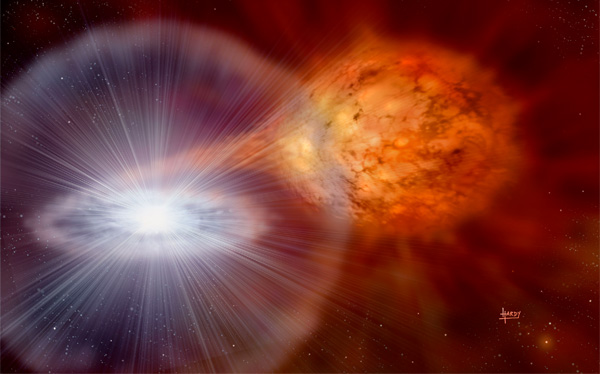Explosion in the Andromeda Galaxy
An SDSU astronomer confirmed a rare recurrent nova eruption.

SDSU astronomy professor Allen Shafter helped discover a rare recurrent nova on the same binary star system first seen by famed astronomer Edwin Hubble.
Hubble observed the star's first nova eruption in 1923; astronomers have designated it M31N 1923-12c.
Now, 88 years later, Shafter and his colleagues confirmed that a second eruption occurred on the same nova in the Andromeda galaxy two million light years away.
“Nova eruptions themselves are very rare as there are only an estimated 40 per year that erupt in a galaxy, like our own Milky Way or the nearby Andromeda galaxy, which contains hundreds of billions of individual stars,” Shafter said.
Allen Shafter's research is one of many ways SDSU faculty are leading innovation and discovery, a key initiative of The Campaign for SDSU. With a unique focus on the teacher-scholar model, SDSU attracts researchers interested in solving the world’s most pressing problems, while showing students how to provide future solutions. Learn more about how SDSU leads innovation and discovery, and how you can help.
What is a nova?
A nova is the result of the interaction between the stars in a binary system. As one star orbits the other, it pulls matter from its sister star until the added material gets so hot and dense that it explodes, creating a “nova eruption.”
“Novae are incredibly bright, releasing as much energy during their brief eruptions, as the sun puts out in 100,000 years,” Shafter said.
About 10 of the observed novae in the Milky Way have had more than one eruption. Only a handful of candidates are considered recurrent novae of the approximately 900 nova eruptions observed in the Andromeda galaxy during the past century.
The recent eruption was first discovered by Japanese amateur astronomers Koichi Nishiyama and Fujio Kabashima.
After precisely measuring M31N 1923-12c’s position according to Hubble’s original photographic plate and comparing it with that of the recent nova, Shafter and colleagues Mike Bode, Matt Darnley, Robin Ciardullo and Francois Schweizer determined that the two eruptions must have arisen from the same binary star system in Andromeda.
About Shafter
Shafter, chair of SDSU’s Department of Astronomy and the only such program in the California State University system, researches nova using the Hobbey-Eberly Telescope in Texas and NASA’s Spitzer Space Telescope.



